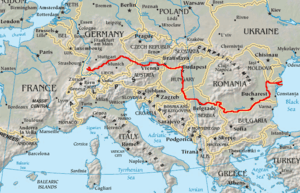Széchenyi Chain Bridge
The Széchenyi Chain Bridge (Hungarian: Széchenyi lánchíd, Hungarian pronunciation: [ˈseːt͡ʃeːɲi ˈlaːnt͡shiːd]) is a chain bridge that spans the River Danube between Buda and Pest, the western and eastern sides of Budapest, the capital of Hungary. Designed by English engineer William Tierney Clark and built by Scottish engineer Adam Clark, it was the first permanent bridge across the Danube in Hungary. It was opened in 1849. It is anchored on the Pest side of the river to Széchenyi (formerly Roosevelt) Square, adjacent to the Gresham Palace and the Hungarian Academy of Sciences, and on the Buda side to Adam Clark Square, near the Zero Kilometre Stone and the lower end of the Castle Hill Funicular, leading to Buda Castle.
Chain Bridge | |
|---|---|
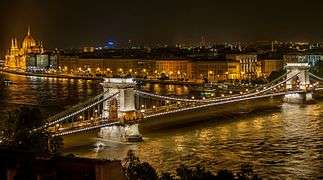 Chain Bridge and the Hungarian Parliament Building | |
| Coordinates | 47°29′56″N 19°02′37″E |
| Carries | 2 road lanes |
| Crosses | Danube River |
| Locale | Budapest |
| Official name | Széchenyi Lánchíd |
| Other name(s) | Lánchíd |
| Characteristics | |
| Design | chain suspension bridge |
| Material | wrought iron and stone[1] |
| Total length | 375 metres (1,230 ft) |
| Width | 14.8 metres (49 ft) |
| Longest span | 202 metres (663 ft) |
| History | |
| Designer | William Tierney Clark |
| Construction start | 1840[1] |
| Construction end | 1849[1] |
| Opened | November 20, 1849 |
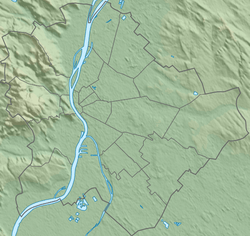 Chain Bridge Location in Budapest | |
The bridge has the name of István Széchenyi, a major supporter of its construction, attached to it, but is most commonly known as the "Chain Bridge". At the time of its construction, it was regarded as one of the modern world's engineering wonders.[2] It has asserted an enormous significance in the country's economic, social and cultural life, much as the Brooklyn Bridge has in New York and the US.[3] Its decorations made of cast iron, and its construction, radiating calm dignity and balance, have elevated the Chain Bridge to a high stature in Europe.[2]
It became a symbol of advancement, national awakening, and the linkage between East and West.[2]
History
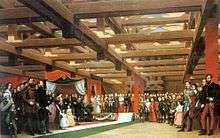
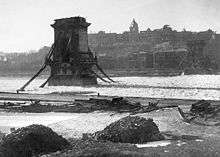
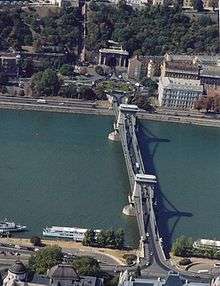
The bridge was designed by English engineer William Tierney Clark in 1839, following an initiative by Count István Széchenyi, with construction supervised locally by Scottish engineer Adam Clark (no relation). It is a larger-scale version of Tierney Clark's earlier Marlow Bridge, across the River Thames in Marlow, England, and was designed in sections and shipped from the United Kingdom to Hungary for final construction.
It was funded to a considerable extent by the Greek merchant Georgios Sinas[4][5][6] who had financial and land interests in the city and whose name is inscribed on the base of the south-western foundation of the bridge on the Buda side.
The bridge opened in 1849, after the Hungarian Revolution of 1848, becoming the first permanent bridge in the Hungarian capital. At the time, its centre span of 202 metres (663 ft) was one of the largest in the world. The lions at each of the abutments were carved in stone by the sculptor János Marschalkó and installed in 1852.[7] They are similar in design to the bronze lions of Trafalgar Square (commissioned in 1858 and installed in 1867).[8] The bridge was given its current name in 1898.
The bridge's cast-iron structure was updated and strengthened in 1914. In World War II, the bridge was blown up on 18 January 1945 by the retreating Germans during the Siege of Budapest, with only the towers remaining. It was rebuilt, and reopened in 1949.[8]
The inscription on each side of the bridge is to "Clark Adam", the bridge builder's name in the local Eastern name order. A plaque on the Pest side of the river reads "To commemorate the only two surviving bridges designed by William Tierney Clark: The Széchenyi Chain Bridge over the Danube at Budapest and the suspension bridge over the Thames at Marlow, England."
In popular culture
In 2001 Hungarian stunt pilot Péter Besenyei flew upside down under the bridge, a manoeuvre that became a standard in Red Bull air races today.
The bridge is featured in I Spy, Au Pair, Walking with the Enemy and Spy, and is the setting of the climax scene in Bollywood blockbuster Hum Dil De Chuke Sanam. The bridge appears briefly in the opening shot of the 2019 Black Widow trailer.
The bridge featured prominently in Matthew Barney's Cremaster 5, serving as a reference to Harry Houdini, and also appears in Dan Brown's novel Origin and in the Season Two premiere episode of Syfy channel's 12 Monkeys, which aired in April 2016.
It also appears at the beginning of the video for Katy Perry's song "Firework", and K-pop vocal duo Davichi's music video for the song "Cry Again".
According to a Hungarian legend, the lions of Széchenyi Chain Bridge have no tongues. This legend is not true, the tongues are just not visible.
References
- Széchenyi Chain Bridge at Structurae
- History of Chain Bridge, Budapest
- No wonder it was called a modern world engineering wonder in 1849
- Pfeiffer, Ida (2008). A Woman's Journey Round the World. BiblioBazaar. p. 514. ISBN 0-554-23516-1.
The small observatory was built by Baron Sina, the well-known banker in Vienna, who is by birth a Greek. The royal palace, which is of modern date, is built of brilliant white marble, in the form of a large quadrangle.
- Kohl, Johann Georg (1844). Austria: Vienna, Prague, Hungary, Bohemia, and the Danube; Galicia, Styria, Moravia, Bukovina, and the Military Frontier. Chapman and Hall. p. 126.
The principal banker, Sina, is a Greek. Since the late improvements in the navigation of the Danube, which have made it possible to travel from Vienna
- Gerő, András; Poór, János (1997). Budapest: a history from its beginnings to 1998. Social Science Monographs. p. 83. ISBN 0-88033-359-6.
In George Sina, a Viennese banker of Greek extraction, he found his financier; in William Tierney Clark his designer and in Adam Clark his engineer
- "Budapest Tourist Guide - Chain bridge".
- "Bridges of Budapest - Chain bridge".
External links
| Wikimedia Commons has media related to Széchenyi Chain Bridge). |


